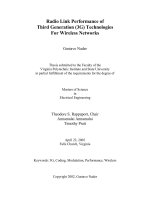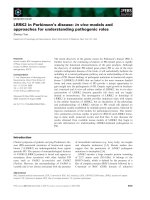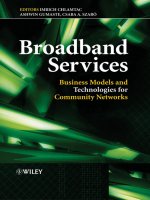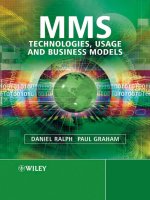broadband services business models and technologies for community networks
Bạn đang xem bản rút gọn của tài liệu. Xem và tải ngay bản đầy đủ của tài liệu tại đây (3.9 MB, 305 trang )
JWBK004-FM JWBK004-Gumaste January 14, 2005 20:19 Char Count= 0
Broadband Services
BUSINESS MODELS
AND TECHNOLOGIES FOR
COMMUNITY NETWORKS
Edited by
Imrich Chlamtac
CreateNet Research Consortium
Ashwin Gumaste
Fujitsu Laboratories, Dallas, USA
and
Csaba A. Szab´o
Budapest University of Technology and Economics, Budapest, Hungary
iii
JWBK004-FM JWBK004-Gumaste January 14, 2005 20:19 Char Count= 0
iii
JWBK004-FM JWBK004-Gumaste January 14, 2005 20:19 Char Count= 0
Broadband Services
i
JWBK004-FM JWBK004-Gumaste January 14, 2005 20:19 Char Count= 0
ii
JWBK004-FM JWBK004-Gumaste January 14, 2005 20:19 Char Count= 0
Broadband Services
BUSINESS MODELS
AND TECHNOLOGIES FOR
COMMUNITY NETWORKS
Edited by
Imrich Chlamtac
CreateNet Research Consortium
Ashwin Gumaste
Fujitsu Laboratories, Dallas, USA
and
Csaba A. Szab´o
Budapest University of Technology and Economics, Budapest, Hungary
iii
JWBK004-FM JWBK004-Gumaste January 14, 2005 20:19 Char Count= 0
Copyright
C
2005 John Wiley & Sons Ltd, The Atrium, Southern Gate, Chichester,
West Sussex PO19 8SQ, England
Telephone (+44) 1243 779777
Email (for orders and customer service enquiries):
Visit our Home Page on www.wiley.com
All Rights Reserved. No part of this publication may be reproduced, stored in a retrieval system
or transmitted in any form or by any means, electronic, mechanical, photocopying, recording,
scanning or otherwise, except under the terms of the Copyright, Designs and Patents Act 1988
or under the terms of a licence issued by the Copyright Licensing Agency Ltd, 90 Tottenham
Court Road, London W1T 4LP, UK, without the permission in writing of the Publisher.
Requests to the Publisher should be addressed to the Permissions Department, John Wiley &
Sons Ltd, The Atrium, Southern Gate, Chichester, West Sussex PO19 8SQ, England, or emailed
to , or faxed to (+44) 1243 770571.
This publication is designed to provide accurate and authoritative information in regard to
the subject matter covered. It is sold on the understanding that the Publisher is not engaged
in rendering professional services. If professional advice or other expert assistance is
required, the services of a competent professional should be sought.
Other Wiley Editorial Offices
John Wiley & Sons Inc., 111 River Street, Hoboken, NJ 07030, USA
Jossey-Bass, 989 Market Street, San Francisco, CA 94103-1741, USA
Wiley-VCH Verlag GmbH, Boschstr. 12, D-69469 Weinheim, Germany
John Wiley & Sons Australia Ltd, 33 Park Road, Milton, Queensland 4064, Australia
John Wiley & Sons (Asia) Pte Ltd, 2 Clementi Loop #02-01, Jin Xing Distripark, Singapore 129809
John Wiley & Sons Canada Ltd, 22 Worcester Road, Etobicoke, Ontario, Canada M9W 1L1
Library of Congress Cataloguing-in-Publication Data
Broadband services : business models and technologies for community
networks / edited by Ashwin Gumaste, Imrich Chlamtac, Csaba Szab´o.
p. cm.
Includes bibliographical references and index.
ISBN 0-470-02248-5 (alk. paper)
1. Broadband communication systems. 2. Electronic villages (Computer networks)
I. Gumaste, Ashwin. II. Chlamtac, Imrich. III. Szab´o, Csaba, (Csaba A.)
TK5103.4.B767 2005
384–dc22 2004022888
British Library Cataloguing in Publication Data
A catalogue record for this book is available from the British Library
ISBN 0-470-02248-5 (HB)
Typeset in 10/12pt Times by TechBooks, New Delhi, India
Printed and bound in Great Britain by Anthony Rowe Ltd, Chippenham, Wiltshire
This book is printed on acid-free paper responsibly manufactured from sustainable forestry
in which at least two trees are planted for each one used for paper production.
iv
JWBK004-FM JWBK004-Gumaste January 14, 2005 20:19 Char Count= 0
Contents
Foreword xv
About the Editors xvii
List of Contributors xix
Acknowledgments xxv
1 Introduction 1
Imrich Chlamtac, Ashwin Gumaste and Csaba A. Szab
´
o
1.1 What is broadband? 1
1.2 The objectives of this book 3
1.3 Book outline 4
Part One Applications and Services 9
2 Broadband Home/Entertainment Services 11
Arieh Moller and Roy Isacowitz
2.1 Introduction 11
2.2 Current broadband and home entertainment markets 12
2.2.1 Television 13
2.2.2 Mobile 14
2.2.3 Consumer products 15
2.3 What drives broadband? 15
2.4 Future broadband entertainment services 17
2.4.1 Television and video 18
2.4.2 Games 18
2.4.3 Music 19
2.4.4 Gambling 19
2.4.5 Internet 20
2.4.6 Mobile 21
2.5 Consumer demographics 22
2.6 Paying for content 23
2.7 Security standards 24
2.7.1 DVB (www.dvb.org) 24
2.7.2 3GPP (www.3gpp.org) 24
v
JWBK004-FM JWBK004-Gumaste January 14, 2005 20:19 Char Count= 0
vi Contents
2.7.3 3GPP2 (www.3gpp2.org) 24
2.7.4 OMA – Open Mobile Alliance (www.openmobilealliance.org) 25
2.7.5 TCG (www.trustedcomputinggroup.org) 25
2.7.6 SVP (www.svp-cp.org) 25
2.7.7 WPA (www.wifialliance.com/OpenSection/protected
access.asp) 25
2.8 Summary 25
3 Applications and Services to Meet Society-Related Needs 27
Csaba A. Szab
´
o
3.1 Introduction 27
3.2 E-education applications 28
3.2.1 Virtual classrooms 28
3.2.2 Web-based learning 29
3.2.3 Technology of e-education 30
3.3 Telemedicine applications 33
3.3.1 What is telemedicine? 33
3.3.2 Overview of telemedicine applications 34
3.3.3 Requirements when transmitting medical diagnostic information 36
3.3.4 Videoconferencing in telemedicine 39
3.3.5 How does society benefit from telemedicine? 42
3.4 E-government applications 42
3.4.1 Overview 42
3.4.2 Providing access to e-government services 43
3.5 Summary 44
Part Two Business Models 47
4 Key Legal and Regulatory Issues Affecting Community Broadband
Projects in the United States 49
Sean A. Stokes and Jim Baller
4.1 Introduction 49
4.2 The benefits of public fiber-to-the-home (FTTH) systems 49
4.3 Burdens and risks of public broadband systems 50
4.4 Legal authority of public entities to provide communication services 51
4.4.1 Federal law encourages, but does not affirmatively empower,
local governments to provide communications services 53
4.4.2 State laws affecting the authority of public entities to provide
communications services 56
4.4.3 Local restrictions 58
4.5 Involvement models and structures 58
4.6 Other considerations 59
4.7 Federal regulatory issues 60
4.7.1 Key definitions 60
4.7.2 Implications of key definitions 61
4.7.3 Access to incumbent network elements under Section 251(c)(3) 63
4.7.4 Pole attachments 64
JWBK004-FM JWBK004-Gumaste January 14, 2005 20:19 Char Count= 0
Contents vii
4.7.5 Universal service 65
4.7.6 Other important federal provisions 66
4.8 State regulatory issues 67
4.8.1 Certification 67
4.8.2 Tariffs 67
4.8.3 Annual reports 67
4.8.4 Universal service and other contributions 67
4.8.5 Regulatory fees 68
4.8.6 Interconnection agreements 68
4.9 Summary 68
5 European Telecommunication Law and Community Networks 69
Giovanni Pascuzzi and Andrea Rossato
5.1 Introduction 69
5.2 Historical background 70
5.2.1 The liberalization period 70
5.2.2 The harmonization effort 71
5.3 The New Regulatory Framework 73
5.3.1 Liberalization 74
5.3.2 National Regulatory Authorities 75
5.3.3 General authorization 76
5.3.4 Access and interconnection 77
5.3.5 Universal service 78
5.3.6 Radio local area networks 79
5.3.7 E-privacy 79
5.4 Member States’ implementation: the Italian case 80
5.4.1 The Italian Electronic Communications Code 80
5.4.2 Internet service provision 82
5.4.3 Radio local area networks 83
5.4.4 A case study: Provincia Autonoma di Trento and
Informatica Trentina 83
5.5 Summary 83
6 Models for Public Sector Involvement in Regional and Local
Broadband Projects 85
Gareth Hughes
6.1 Introduction 85
6.2 Overview of models for public involvement 85
6.2.1 Community-operated networks and services 86
6.2.2 Carrier’s carrier model 87
6.2.3 Passive infrastructure model 88
6.2.4 Fiber condominium 89
6.2.5 Aggregation of demand 90
6.2.6 Summary of models 91
6.3 Financial profiles of different models 91
6.4 Public–private partnerships 93
JWBK004-FM JWBK004-Gumaste January 14, 2005 20:19 Char Count= 0
viii Contents
6.5 Legal and economic considerations relating to models 94
6.5.1 Aggregation of public sector demand 95
6.5.2 Financial aid to an operator 95
6.5.3 Community-operated networks and services 96
6.5.4 Carrier’s carrier model 96
6.5.5 Passive infrastructure model 96
6.6 Summary 101
7 Customer-Owned and Municipal Fiber Networks 103
Bill St. Arnaud
7.1 Introduction 103
7.1.1 Customer-owned dark fiber 103
7.1.2 Condominium fiber 104
7.1.3 Community or municipal fiber networks 105
7.2 Advantages of customer-owned dark fiber/municipal fiber to different
users and businesses 105
7.2.1 Public institutions 105
7.2.2 Business organizations 107
7.2.3 Office building owners and managers 108
7.2.4 Consumers or home owners 109
7.2.5 Municipalities and governments 110
7.3 Deployment of municipal fiber networks 110
7.3.1 Rights of way and Municipal Access Agreements (MAAs) 110
7.3.2 Carrier neutral collocation facilities 111
7.3.3 Equipment to light up dark fiber 112
7.4 Cost analysis 112
7.4.1 Overview 112
7.4.2 Some detailed cost components of customer-owned dark fiber 113
7.4.3 Ongoing yearly costs for customer-owned dark fiber 115
7.5 Operation and management 116
7.5.1 Reliability of dark fiber 116
7.5.2 Operation and maintenance 116
7.6 Summary 117
8 Towards a Technologically and Competitively Neutral
Fiber-to-the-Home (FTTH) Infrastructure 119
Anupam Banerjee and Marvin Sirbu
8.1 Introduction 119
8.2 Models for competition in telecommunications 120
8.2.1 Facilities-based competition 120
8.2.2 Non facilities-based competition or service level competition 120
8.3 Fiber-to-the-home architectures 121
8.3.1 Home run fiber 122
8.3.2 Active star 123
8.3.3 Passive star (passive optical network–PON) 123
8.3.4 WDM passive optical networks 126
JWBK004-FM JWBK004-Gumaste January 14, 2005 20:19 Char Count= 0
Contents ix
8.4 Economics of fiber-to-the-home 126
8.4.1 Cost model assumptions 126
8.4.2 Cost model results 127
8.4.3 OFAP as a real option: PON design under uncertainty 127
8.4.4 Sensitivity analysis 131
8.5 Competition, FTTH architecture and industry structure 132
8.5.1 Facilities-based competition 132
8.5.2 Competition at the optical layer 132
8.5.3 Data link layer (UNE-based) competition 133
8.5.4 Network (and higher) layer-based (open access) competition 134
8.5.5 Why UNE-based competition may be preferable to open
access-based competition 134
8.5.6 Necessary conditions for competition in FTTH 135
8.5.7 Industry structure, fiber ownership and competition 136
8.6 Summary 138
Part Three Technology 141
9 Backbone Optical Network Design for Community Networks 143
Ashwin Gumaste, Csaba A. Szab
´
o and Imrich Chlamtac
9.1 Introduction 143
9.2 Design considerations for community metro networks 144
9.2.1 The first generation metro rings 145
9.2.2 The WDM solution 147
9.2.3 The Ethernet solution 148
9.2.4 Resilient packet rings (RPR) 152
9.3 Functions of the backbone: aggregation and transport – evolution
of the MSPP and MSTP concepts 152
9.4 The optical backbone: design and elements 155
9.4.1 Routing and wavelength assignment: a problem for
interconnected ring networks 156
9.4.2 Mesh optical networks 156
9.4.3 Ring network element design considerations 157
9.4.4 Fixed OADMs (FOADMs) 157
9.4.5 Reconfigurable OADMs (ROADMs) 157
9.4.6 Dynamic OADMs (DOADMs) 157
9.4.7 Architectural notes on ring OADMs 158
9.5 Design considerations for the community backbone 159
9.6 Summary 161
10 A Comparison of the Current State of DSL Technologies 163
Scott A. Valcourt
10.1 Introduction 163
10.2 ADSL vision and history 164
10.3 ADSL technology 165
10.4 SHDSL technology 168
JWBK004-FM JWBK004-Gumaste January 14, 2005 20:19 Char Count= 0
x Contents
10.5 VDSL technology 169
10.6 The best technology 170
10.7 DSL community networks 170
10.8 Summary 172
11 Fiber in the Last Mile 173
Ashwin Gumaste, Nasir Ghani and Imrich Chlamtac
11.1 Introduction 173
11.2 Topological and architectural model for PON systems: associated
nomenclature 174
11.3 Types of passive optical network 175
11.3.1 ATM, or broadband PONs 175
11.3.2 EPONs, or Ethernet PONs 176
11.3.3 WDM PONs 177
11.4 Optical signal details to be considered while designing a PON system 178
11.4.1 Optical signal-to-noise ratio 179
11.5 Components for PON systems 179
11.6 Protocol requirements for OLT–ONU interaction 183
11.6.1 Transmission upon reception (TUR) 183
11.6.2 IPACT: interleaved polling with adaptive cycle time 183
11.7 MPCP classifications and requirements 184
11.7.1 Dynamic provisioning 184
11.7.2 Fairness 184
11.7.3 QoS 185
11.7.4 Stability and convergence 185
11.7.5 SLA provisioning 185
11.8 Summary 185
12 Ethernet in the First Mile 187
Wael William Diab
12.1 Introduction 187
12.2 Overview of the IEEE, the process and the 802.3 Working Group 187
12.2.1 The LMSC 187
12.2.2 The Ethernet Working Group and the IEEE process 188
12.2.3 A brief discussion on the five criteria 188
12.3 Overview of the EFM Task Force and timeline 189
12.3.1 P802.3ah: overview of EFM 189
12.3.2 Practically, why is 802.3ah important? 189
12.3.3 Timeline of the EFM project 190
12.4 Overview of OAM 190
12.4.1 High-level architecture 190
12.4.2 Functionality 191
12.4.3 Single link management 191
12.4.4 Restrictions 192
12.5 Overview of copper 192
12.5.1 High-level architecture 192
JWBK004-FM JWBK004-Gumaste January 14, 2005 20:19 Char Count= 0
Contents xi
12.5.2 More on the specifics of each type of copper link 193
12.5.3 Support for multiple pairs 193
12.6 Overview of optics 193
12.6.1 High-level summary 193
12.6.2 High-level architecture: common motivations 194
12.6.3 Detailed description of the optical devices 194
12.6.4 Philosophy for both single and dual fiber 100 M 195
12.6.5 Philosophy for dual wavelength for the single fiber solutions 195
12.6.6 Differences between the 100 M and 1 Gigabit point-to-point
solutions 196
12.6.7 New requirements for EPONs 197
12.6.8 Optical reach 197
12.6.9 Extended temperature 197
12.7 Overview of EPONs: the logic behind P2MP 198
12.7.1 High-level architecture 198
12.7.2 A note on terminology 198
12.7.3 MPCP: a more detailed discussion 199
12.7.4 The functional responsibilities of the ONU and OLT 199
12.8 Summary 200
13 DOCSIS as a Foundation for Residential and Commercial
Community Networking over Hybrid Fiber Coax 201
Steven Fulton, Chaitanya Godsay and Radim Barto
ˇ
s
13.1 Introduction 201
13.1.1 Distribution distance 202
13.1.2 Frequency range 202
13.1.3 Broadband deployment growth 204
13.1.4 Broadband deployment future 204
13.2 Provisioning process for DOCSIS connections 206
13.2.1 DOCSIS provisioning basics 207
13.2.2 Ranging and registration 208
13.2.3 Upstream data transmission 210
13.2.4 Downstream data transmission 213
13.3 Summary 213
14 Broadband Wireless Access Networks: a Roadmap on Emerging
Trends and Standards 215
Enzo Baccarelli, Mauro Biagi, Raffaele Bruno, Marco Conti and Enrico Gregori
14.1 Introduction 215
14.2 What is Broadband Wireless Access? 216
14.2.1 QoS requirements for BWA 216
14.2.2 A ‘workable’ definition of BWA 217
14.2.3 BWA in personal, local, metropolitan and wide area networks 217
14.3 Technologies for WPANs: the 802.15 standards 218
14.3.1 IEEE 802.15.1: a Bluetooth-based WPAN 218
14.3.2 High-rate WPANs: the IEEE 802.15.3 standard 219
JWBK004-FM JWBK004-Gumaste January 14, 2005 20:19 Char Count= 0
xii Contents
14.4 Emerging 4G WLANs 220
14.4.1 Technologies for 4G WLANs: the IEEE 802.11 standards 221
14.4.2 Network architectures 222
14.4.3 High-speed WLANs: 802.11a and 802.11g 222
14.4.4 Quality of Service in 4G WLANs: the 802.11e standard 224
14.4.5 Future directions 226
14.5 Wireless backbone and wireless local loop: the IEEE 802.16 standards 228
14.5.1 Service scenarios and network architectures 229
14.5.2 Physical layer for wireless backbone 232
14.5.3 Future directions 233
14.6 Satellite access and services 235
14.6.1 Geosynchronous Earth orbit (GEO) satellites and
video broadcasting 235
14.6.2 Towards broadband low Earth orbit (LEO) satellites 236
14.7 Summary: future BWA roadmap and diverse technology landscape 237
Part Four Case Studies 241
15 Community Case Studies in North America 243
Priya Shetty and Ashwin Gumaste
15.1 Introduction 243
15.2 Issues affecting community network design 244
15.2.1 Technology considerations 244
15.2.2 Business considerations 245
15.2.3 Social issues 245
15.3 Case studies 246
15.3.1 Case study 1: Douglas County School System, Georgia 246
15.3.2 Case study 2: Washington’s DC-Net through MCI 248
15.3.3 Case study 3: broadband power line system in Cape
Girardeau, Missouri 250
15.3.4 Case study 4: wireless broadband community network for
City of oceanside, California 251
15.3.5 Case study 5: citywide wireless network for Mount
Pleasant, Michigan 252
15.4 Summary 254
16 European Broadband Initiatives with Public Participation 255
Csaba A. Szab
´
o
16.1 Introduction 255
16.2 Stokab’s dark fiber metro net in the Stockholm region – a profitable
project in business terms 256
16.2.1 Overview 256
16.2.2 Connection provisioning and pricing 257
16.2.3 Collocation and location services 257
16.2.4 Customers 257
16.3 FastWeb–anewgeneration of telecommunications networks and services 258
JWBK004-FM JWBK004-Gumaste January 14, 2005 20:19 Char Count= 0
Contents xiii
16.4 Community networks based on PLC: the Endesa field trials in Spain 260
16.4.1 Why PLC? 260
16.4.2 Network technology using PLC 262
16.4.3 Business models 263
16.4.4 The mass field trial in Zaragoza 264
16.5 Broadband to rural areas via satellite – the South West Broadband
Programme in Ireland 265
16.6 Regional broadband aggregation in the UK 267
16.7 Summary 271
Index 273
JWBK004-FM JWBK004-Gumaste January 14, 2005 20:19 Char Count= 0
xiv
JWBK004-FM JWBK004-Gumaste January 14, 2005 20:19 Char Count= 0
Foreword
It has been shown that there is a correlation between the broadband adoption rate and the gross
national products of various countries. Therefore, all industrial countries are racing to ensure
that their citizens have the best possible broadband access. In addition to national governments,
local governments and municipal organizations are taking steps to increase the broadband ac-
cess to their populations. Providing broadband access to citizens, communities, and public
institutions and developing businesses has become a strategic objective for governments and
international organizations worldwide. However, the solution to these problems is not straight-
forward. Although the appropriate technologies are there, ranging from the almost ubiquitous
ADSL, cable modems, to fiber-to-the premises and broadband wireless access, telecommu-
nication and cable companies cannot deploy them as the large costs and very long return of
investment makes it prohibitive according to their usual business models.
Providing broadband infrastructure in sparsely populated, geographically challenged areas,
usually underserved by service providers, is a very important goal for local governments. A
large number of initiatives, under the collective name community networks or municipal fiber
networks or metro fiber networks have been launched in North America as well as in Europe.
By creating broadband infrastructure in underserved regions, governments can prevent remote
communities from “digital divide,” and are able to create a climate for economic development,
help startups to grow, bring new businesses into the region thus resulting in a healthy climate
for economic development.
There is a variety of business models for public entity’s participation in building backbone
and access networks for communities. According to the one of the most common models, the
public administration enters the market, directly or indirectly, as an infrastructure provider,
offering basic infrastructure such as ducts and “dark fiber”, to other entities which act as
service providers for the end users. This model also allows for fostering the competition
in the broadband access market by creating an alternative infrastructure to the incumbent
telecommunication operator. The right business model depends on national and local telecom
regulations, competition regulation and of course economic considerations.
This book, Broadband Services: Business Models and Technologies for Community Net-
works, edited by Imrich Chlamtac, Ashwin Gumaste and Csaba A. Szab´o brings together the
most important aspects of the problem – technical, legal, regulatory and economic – into one
book. The emerging business models and state-of-the-art technologies for broadband networks
are covered by an exclusive group of contributing authors from academia, industry and public
bodies, including the editors themselves. The editors successfully integrated different contribu-
tions into a unified text that provides an integrated view of applications, business considerations
xv
JWBK004-FM JWBK004-Gumaste January 14, 2005 20:19 Char Count= 0
xvi Foreword
and technology aspects of delivering broadband services to business, public and residential
users.
There is no similar book currently available in the market. While there exist separate texts on
optical or wireless networks, the whole gamut of technologies is not covered in a single book.
The technology parts are understandable for the non-technical readers, too. The integrated
approach and the coverage of interrelated legal, regulatory and economic issues makes the
book really unique. It will be useful for a wide circle of specialists involved in engineering,
network planning, business modeling, implementing and operating broadband infrastructures
and services, as well as for researchers, academicians, students interested in the various fields.
Raj Jain
Co-Founder and CTO of Nayna Networks, San Jose, CA
Ex-Professor of Computer Science and Engineering,
Ohio State University, Columbus, OH
Fellow of IEEE and Fellow of ACM
/>JWBK004-FM JWBK004-Gumaste January 14, 2005 20:19 Char Count= 0
About the Editors
Imrich Chlamtac is the President of CreateNet and holds the Distinguished Chair in
Telecommunications Professorship at the University of Texas at Dallas, and Bruno Kessler
Honorary Professorship from the University of Trento, Italy.
Dr Chlamtac is known as the inventor of the lightpath concept, the basic mechanism for
wavelength routing, a key optical technology for WDM networking, and was the first to intro-
duce the fundamental concepts of multihop ad hoc networking. For his various contributions,
Dr Chlamtac was elected Fellow of the IEEE, Fellow of the ACM, and, among various awards,
received the 2001 ACM Award for Outstanding Contributions to Research on Mobility and the
2002 IEEE Award for Outstanding Technical Contributions to Wireless Personal Communica-
tions. He is also the recipient of the MIUR CENECA award in Italy, the Sackler Professorship
from Tel Aviv University, the University Professorship at the Budapest University of Technol-
ogy and Economics, and Fulbright Scholarship.
Dr Chlamtac has published over three hundred and fifty refereed journal, book and confer-
ence articles and is the co-author of four books, including the first textbook on LANs entitled
Local Networks: Motivation, Technology and Performance (1980) and Wireless and Mobile
Network Architectures, John Wiley & Sons (2002), an IEEE Network Editor’s choice, and
Amazon.com engineering bestseller.
Dr Chlamtac has contributed to the scientific community as founder and Chair of ACM Sig-
mobile, and founder and steering committee chair of several leading conferences in networking,
including Mobicom, OptiComm, Mobiquitous, Broadnets, WiOpt and others.
Dr Chlamtac also serves as the founding Editor in Chief of the ACM/URSI/Kluwer Wireless
Networks (WINET), the ACM/Kluwer Journal on Special Topics in Mobile Networks and
Applications (MONET).
Ashwin Gumaste is with Fujitsu Laboratories in the Photonics Networking Laboratory (PNL)
group in Richardson, Texas, where his research includes designing next generation photonic
and data systems.
Prior to Fujitsu Laboratories, Ashwin received a PhD in Electrical Engineering from the
University of Texas at Dallas. Ashwin has previously worked in Fujitsu Network Communi-
cations R&D and prior to that with Cisco Systems under the Optical Networking Group.
He has written numerous papers and has over thirty pending US and EU patents. During
1991, Ashwin was awarded the National Talent Search Scholarship in India. His research
interests include optical and wireless networking and uncertainty equilibria in social and net-
working environments. He proposed the first architecture to implement optical burst transport
xvii
JWBK004-FM JWBK004-Gumaste January 14, 2005 20:19 Char Count= 0
xviii About the Editors
and dynamic lightpath provisioning, called Light-trails, and also proposed the Light-frame
framework – a conceptual model for future packet mode optical communication.
Dr Gumaste has authored two books on broadband networks DWDM Network Designs and
Engineering Solutions, and First Mile Access Networks and Enabling Technologies.
Csaba A. Szab´o received his PhD from the Budapest University of Technology and Economics
(BUTE) and a Doctor of Technical Sciences title from the Hungarian Academy of Sciences.
He is a Professor at the Department of Telecommunications of BUTE, a member of the Board
of Directors of CreateNet, an international research center based in Trento, Italy, and a member
of the Advisory Board of the ICT Graduate School of the University of Trento.
Dr Szab´o has achieved recognized research results in multi-access communications and
metropolitan area networks. He has published over 50 journal papers, numerous conference
presentations and authored or co-authored five monographs. His recent research interests in-
clude multimedia communications and planning of community networks.
Dr Szab´o has been a member of editorial boards of several leading journals, including Com-
puter Networks and ISDN Systems. His recent conference organizing activity includes WONS
(2004, 2005), OptiComm (2003), the 1st International Workshop on Community Networks
and FTTx, where he was a keynote speaker (2003), WiCon and TridentCom (2005). He is a
General Co-Chair of the Multimedia Services Access Networks (MSAN) conference and the
organizer of the 2nd Workshop on Community Networks.
Dr Szab´o is a Senior Member of the IEEE and is listed in the Marquis Who is Who in the
World, Millenium Edition.
JWBK004-FM JWBK004-Gumaste January 14, 2005 20:19 Char Count= 0
List of Contributors
Enzo Baccarelli
INFO-COM Department
University of Rome ‘La Sapienza’
Rome
Italy
Jim Baller
The Baller Herbst Law Group
2014 P Street
N.W. Suite 200
Washington DC
20036
USA
Anupam Banerjee
Department of Engineering and Public Policy
Carnegie Mellon University
5000 Forbes Avenue
Pittsburgh
PA 15213
USA
anupam
Radim Bartoˇs
Department of Computer Science
121 Technology Drive Suite 2
Durham
NH 03824
USA
xix
JWBK004-FM JWBK004-Gumaste January 14, 2005 20:19 Char Count= 0
xx List of Contributors
Mauro Biagi
INFO-COM Department
University of Rome ‘La Sapienza’
Rome
Italy
Raffaele Bruno
IIT-CNR Pisa
Via G. Moruzzi 1
56124
Pisa
Italy
Imrich Chlamtac
CreateNet Research Consortium
Via Solteri 38
38100
Trento
Italy
Marco Conti
IIT-CNR Pisa
Via G. Moruzzi 1
56124
Pisa
Italy
Wael William Diab
Chief Editor, IEEE 802.3ah Task Force (EFM),
Secretary, IEEE 802.3 Working Group (Ethernet),
Technical Leader, Cisco Systems
Steven Fulton
InterOperability Laboratory
121 Technology Drive Suite 2
Durham
NH 03824
USA
JWBK004-FM JWBK004-Gumaste January 14, 2005 20:19 Char Count= 0
List of Contributors xxi
Nasir Ghani
Box 5004
Dept. ECE
Tennessee Technical University
Cookeville
TN 38505
USA
Chaitanya Godsay
Department of Computer Science
121 Technology Drive Suite 2
Durham
NH 03824
USA
Enrico Gregori
IIT-CNR Pisa
Via G. Moruzzi 1
56124
Pisa
Italy
Ashwin Gumaste
Fujitsu Laboratories
7421 Frankford Road
631 Dallas
Texas
75252
USA
Gareth Hughes
eris@
The European Regional
Information Society Association
19 Rue de Pavie
B-1000 Brussels
Belgium
Roy Isacowitz
NDS Israel Ltd
PO Box 23012
Har Hotzvim
Jerusalem
91235
Israel
JWBK004-FM JWBK004-Gumaste January 14, 2005 20:19 Char Count= 0
xxii List of Contributors
Arieh Moller
NDS Israel Ltd
PO Box 23012
Har Hotzvim
Jerusalem
91235
Israel
Giovanni Pascuzzi
Universita di Trento
Via Verdi 53
38100
Trento
Italy
Andrea Rossato
Universita di Trento
Via Verdi 53
38100
Trento
Italy
Priya Shetty
MS–HR10
The University of Texas at Dallas
PO Box 830688
Richardson TX
75083 – 0688
USA
Marvin Sirbu
Department of Engineering and Public Policy
Carnegie Mellon University
5000 Forbes Avenue
Pittsburgh
PA 15213
USA
Bill St. Arnaud
CANARIE Inc.
110 O’Connor Street, 4th Floor
Ottawa
Ontario
K1P 5M9
Canada









